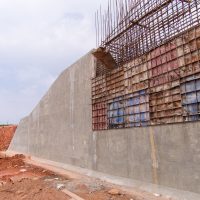A wall is really boring until it fails. A retaining wall is supposed to hold back soil to either support a structure or keep a space clear. When it fails, both of those roles are compromised. A retaining wall does not have to collapse to fail. In fact, a failure is perhaps better defined as when the wall does not perform as expected.
A retaining wall is a structure that is designed to provide lateral support for soil or rock and vertical loads. For example, a basement wall supports both lateral soil loads and the vertical loads of the walls, floors and the roof. Conventional retaining walls are gravity walls, counterfort walls, cantilevered walls and crib walls. Gravity retaining walls are typically built of plain concrete or stone, and the self-weight is a mechanism to resist failure from overturning and sliding. Counterfort walls include a footing, wall stem and vertical ribs known as counterforts that tie the footing and wall stem together. Crib walls are made of interlocking concrete members that form cells that are then filled with compacted soil. There are also proprietary systems such as prefabricated concrete T-walls.
There are several types of cantilevered walls, with common features being a footing that supports a vertical wall stem. Cantilever wall shapes can be T-shaped, L-shaped, or reverse L-shaped. To prevent the buildup of hydrostatic water pressure on the retaining wall, clean granular material is good practice for backfill and a geofabric wrapped pervious drainage system is included at the heel of the wall.
There are many different reasons why retaining walls fail, such as soil bearing, sliding, overturning, inadequate design, improper construction, or unexpected loadings. Other causes of failure include the following:
- A typical cause of failure is when the wall is backfilled with fine grained soils such as silt or clay that have a low shear strength. They also have a low permeability. As a result, they can become saturated with heavy rainfalls and overload the wall. The clay backfill can also exert swelling pressures on the wall. The swelling pressures develop when water infiltrates the clay backfill that was originally compacted to a high dry density at a low moisture content.
- To reduce construction costs, soil available on site is sometimes used for backfill. These soils have a lower strength and permeability than clean granular material. Using in-situ available soil, rather than importing granular material, is perhaps the most common reason for retaining wall failures.
- Detailing errors, perhaps of the steel reinforcement, can lead to misinterpretation by the contractor.
- Foundation problems can be prevented with a geotechnical investigation. A soils report will provide criteria for design such as, the allowable soil bearing capacity, friction factor for sliding resistance, seismic, expansive soil or potential liquefaction. If a soils report is not provided, building codes provide minimum recommend values for bearing capacity, friction resistance, and allowable passive pressure.
Whether the retaining wall is tilting out of plumb, cracking, or collapsing all together, the reasons for these types of failures may be the result of a combination of causes. When in need of a retaining wall expert to provide a failure analysis in the event of a construction defect, contact Warren and let us help you get to the facts.
Founded in 1997, The Warren Group, forensic engineers and consultants provides technical investigations and analysis of personal injury and property claims as well as expert testimony for insurance adjusters and attorneys. Extremely well versed in the disciplines of mechanical, electrical, chemical, structural, accident reconstruction and fire and explosion investigation, our engineers and consultants are known for delivering the truth — origin, cause, responsibility and cost of an event or claim — with unmistakable clarity.





